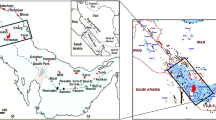Abstract
Research on the molecular fossil characteristics of heavy oil from Well Tadong-2 is of great importance to constrain the source of marine crude oils in the Tarim Basin, Xinjiang, China. The authors synthetically applied the isotope mass spectrograph, chromatography and chromatography-mass spectrography to the studies of molecular fossil characteristics of heavy oil from Well Tadong-2 in the Tarim Basin, and the results obtained revealed that heavy oil from Well Tadong-2 is characterized by high gammacerane, high C28 sterane, low rearranged sterane and high C27-triaromatic steroid, these characteristics are similar to those of Cambrian-Lower Ordovician source rocks, demonstrating that Cambrian crude oils came from Cambrian-Lower Ordovician source rocks; condensed compounds (fluoranthene, pyrene, benzo[a]anthracene, bow, benzo fluoranthene, benzopyrene) of high abundance were detected in heavy oil from Well Tadong-2, and the carbon isotopic values of whole oil are evidently heavy, all the above characteristics revealed that hydrocarbons in the crude oils became densified in response to thermal alteration.
Similar content being viewed by others
References
Liang Digang and Chen Jianping (2005) Oil-source correlations for high and over matured marine source rocks in South China [J]. Petroleum Exploration and Development. 32, 8–14 (in Chinese with English abstract).
Liang Digang, Zhang Shuichang, Zhang Baomin et al. (2000) Understanding on marine oil generation in China based on Tarim Basin [J]. Earth Science Frontier. 7, 534–547 (in Chinese with English abstract).
Lin Qing, Lin Renzi, Wang Peirong et al. (2001) Crude types and main source rocks in west part of north slope, central Tarim [J]. Oil & Gas Geology. 22, 150–153 (in Chinese with English abstract).
Ma Anlai, Zhang Shuichang, Zhang Dajiang et al. (2004a) Oil and source correlation in Lunnan and Tahe heavy oilfields [J]. Oil & Gas Geology. 25, 31–38 (in Chinese with English abstract).
Ma Anlai, Zhang Shuichang, Zhang Dajiang et al. (2004b) Geochemistry of the heavy oils from Well TD-2 in Tarim Basin, NW China [J]. Geological Science and Technology Information. 23, 59–62 (in Chinese with English abstract).
Peters K.E. and Moldowan M. (1993) The Biomarker Guide: Interpreting Molecular Fossils in Petroleum and Ancient Sediments [M]. Prentice Hall Inc, New Jersey.
Sun Yushan, Jin Yingai, Gu Qiaoyuan et al. (2003) Timing of paleo-oil accumulation in Tadong No. 2 Well, Tarim Basin [J]. Petroleum Exploration and Development. 30, 31–33 (in Chinese with English abstract).
Tang Youjun, Wen Zhigang, and Zan Ling (2008) The geochemical characteristics and oil-source rock correlation of oilshow from the Majiashan profile, Chaoxian County, South of Anhui Province [J]. Chinese Journal of Geochemistry. 27, 53–57.
Tang Youjun, Zan Ling, Hou Dujie, and Xiao Zhongyao (2008) The Geochemical characteristics and origin of crude oil in Kekeya Oilfield, Xinjiang, China [J]. Chinese Journal of Geochemistry. 27, 420–423.
Xiao Zhongyao, Huang Guanghui, Lu Yihong et al. (2004) Origin of oils frim Well Tadong-2 in Tarim Basin [J]. Acta Sedimentologica Sinica. 22(supp.), 66–72 (in Chinese with English abstract).
Zhang Liping, Huang Difan, and Liao Zhiqin (1999) Gammacerane-geochemical indicator of water column stratification [J]. Acta Sedimentologica Sinica. 17, 136–140 (in Chinese with English abstract).
Zhang Shuichang, Liang Digang, Li Maowen et al. (2002) Molecular fossils and oil-source rock correlations in Tarim Basin, NW China [J]. Chinese Science Bulletin. 47(supp.), 16–23.
Zhang Shuichang, Liang Digang, Zhang Baomin et al. (2005) Marine Oil Generation in Tarim Basin [M]. pp.270–340. Petroleum Industry Press, Beijing (in Chinese).
Zhang Shuichang, Wang Zhaoming, Wang Feiyu et al. (2004) Oil accumulation history in Tadong-2 oil reservoir in Tarim Basin, NW China—A case study of oil stability and cracking [J]. Petroleum Exploration and Development. 31, 25–31 (in Chinese with English abstract).
Author information
Authors and Affiliations
Corresponding author
Rights and permissions
About this article
Cite this article
Tang, Y., Zan, L. Molecular fossils and sources of Cambrian heavy oil of Well Tadong-2 in the Tarim Basin, Xinjiang, China. Chin. J. Geochem. 28, 314–319 (2009). https://doi.org/10.1007/s11631-009-0314-4
Received:
Accepted:
Published:
Issue Date:
DOI: https://doi.org/10.1007/s11631-009-0314-4




